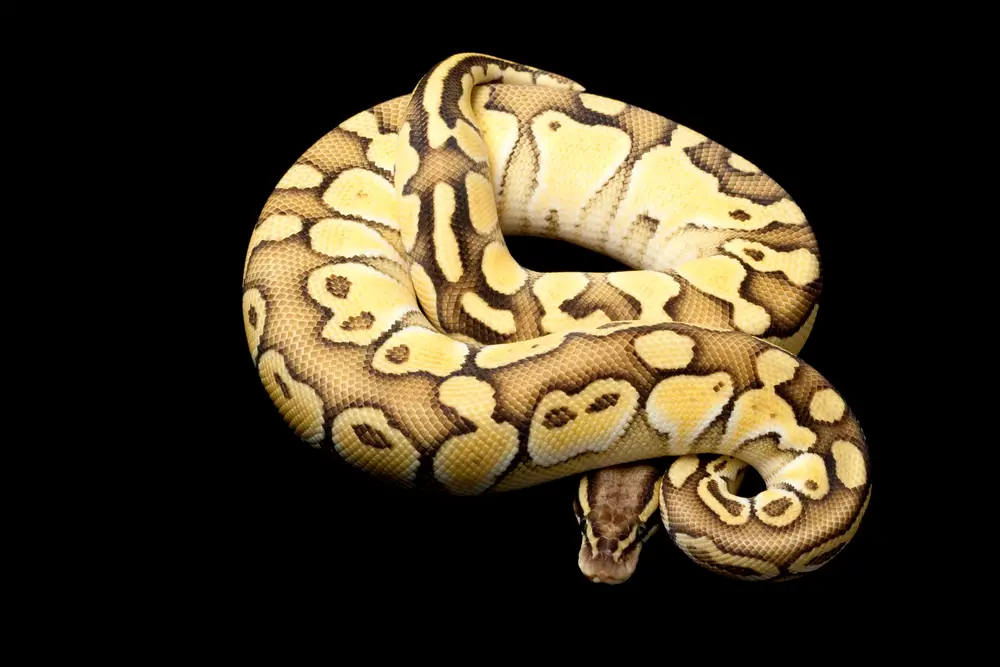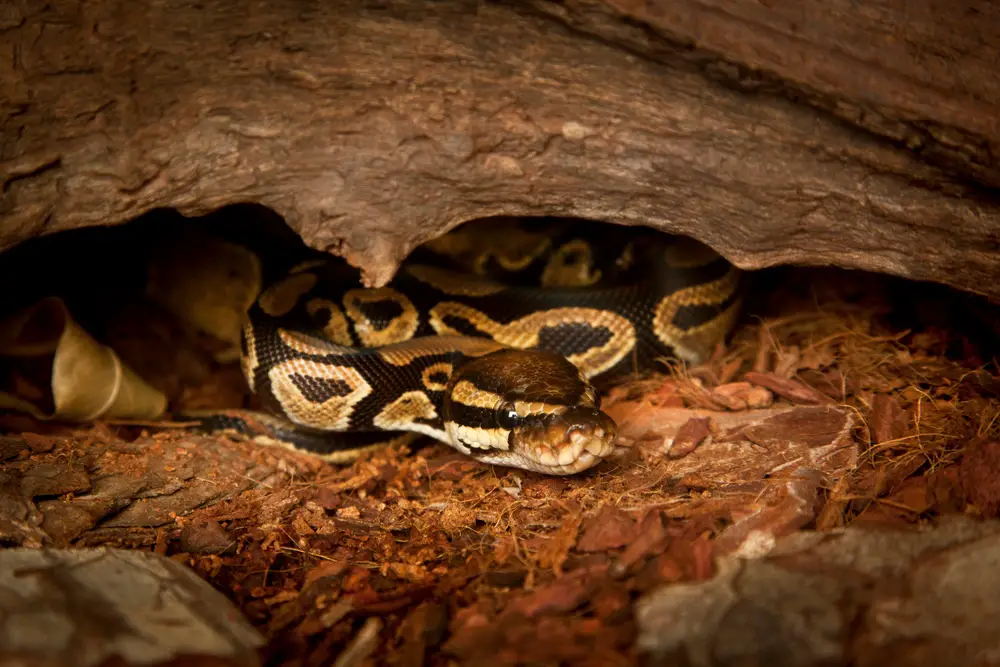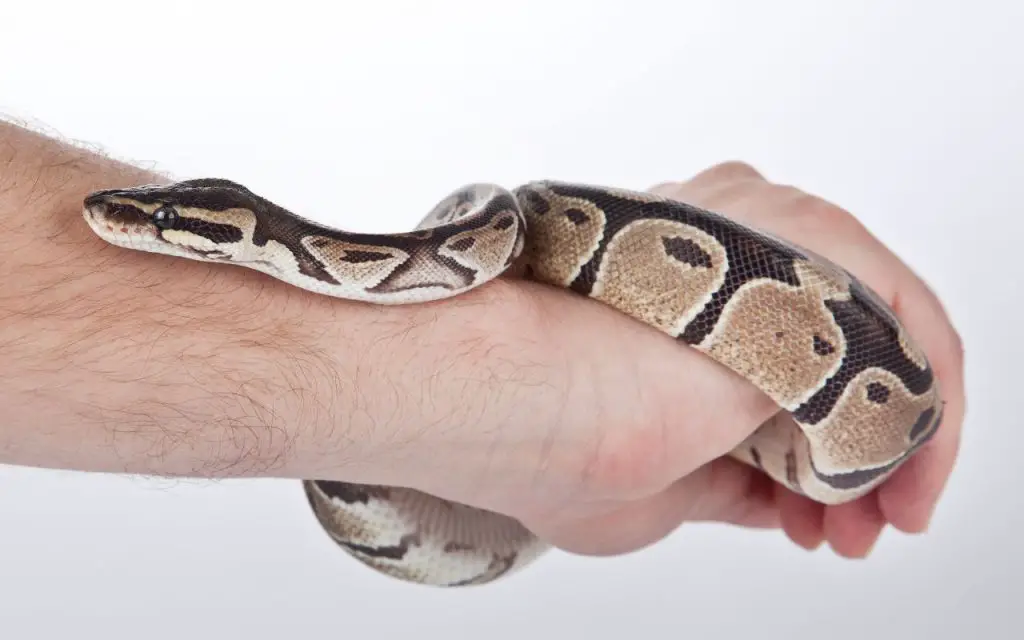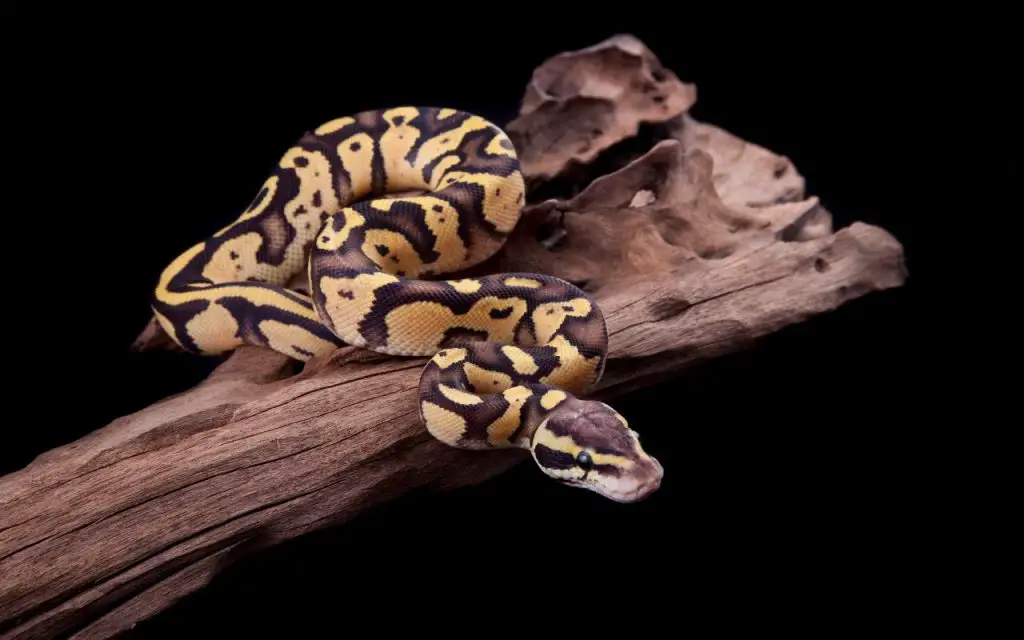Understanding Ball Python body language is vital if you want to keep this species because It can tell you if your snake is stressed, hungry, or even sick. Like most animals, Ball Pythons have a range of non-verbal cues that convey information – we just need to know how to interpret them.
In this article we’ll cover all aspects of Ball Python body language. I’ll tell you how to recognize positive body language towards the end, but to start with I’m going to discuss defensive body language, and behaviors associate with illness. That way, we’ll get the most urgent information to you first…
Balling up
Obviously I can’t talk about Ball Python body language without talking about the behavior they’re famous for: balling up. This is how they got their common name of Ball Python, after all! It simply means rolling into a ball, with the head in the middle.
This behavior is what the snakes do when they are frightened, and they do it especially often if they’re new to your home or very young. Occasionally, adults will also do it when they’re shedding and don’t want to be disturbed.
Whilst it looks like a really useless form of defense, balling up is actually quite smart. You see, Ball Pythons aren’t that tough. In fact, I never have had a truly painful bite from one.
Because they’re aware of this fact, many of them go for this simple defense mechanism because it lets them hide their head in the center of their coils. This means any predator can only attack their back. Their head is protected in the center, and the internal organs are protected by their ribcage.
If your snake does this, don’t worry – it’s perfectly normal and it will stop over time. Just stick to gentle handling once or twice a week.

Defensive Body Language Signals of Ball Pythons
On the other side of the behavioral spectrum we have defensive Ball Pythons. These guys try to do a lot of bluffing to try to scare predators away instead. Again, this is a lot more common with hatchlings and new pets.
Defensive body language signals include:
- Puffing up
- Going stiff
- Adopting an “S” posture
- Sudden head movement
- Hissing
1. Puffing up
This is when a Ball Python takes a deep breath and holds it. When it does this, it’s hoping to make itself look bigger and more intimidating. Most of the time they only do this for a minute or two before relaxing.
2. Going stiff
Often, the same snake that puffs up will also go stiff. What is the point of this? I’m not 100% sure. It may be that it’s hard to move when puffed up, or it may be the case that the snake things if it doesn’t move you’ll think it’s dead and leave it alone.
3. Adopting an “S” posture
This one’s pretty easy to interpret no matter what species does it. It simply means back off or I’ll strike! Of course, most of the time they don’t actually strike, but it’s best to take note anyhow.
4. Sudden head movement
Some defensive Ball Pythons and even some tame ones will occasionally jerk their head backwards quickly. This is how they dodge attacks from predators, and usually means that a sudden movement you made has made them feel threatened.
5. Hissing
Just like the “S” posture, hissing is a clear sign that your snake is moody. Defensive animals will often hiss loudly when you first lift up their hide and try to get them out.

Understanding Stress and defensiveness
Whilst it’s good to understand what defensive behavior is, it’s even better to understand what causes it. In my experience, stress is almost always the root cause.
Common indicators of a stressed Ball Python (asides from defensiveness) include:
- Refusing to eat
- Restlessness
- Failure to thermoregulate (not using the warm spot)
- Never coming out of hiding
- Never using their hiding place (yes, I know it’s the opposite of the last one!)
Some types of stress are normal, whereas others need to be remedied by you, the keeper. Normal types of stress include:
- When shedding
- After you first bring the snake home
- When a young snake hasn’t been tamed yet
These are situations that you can’t avoid, and don’t require any action from you. Abnormal types of stress, on the other hand, need immediate action, and are pretty self-explanatory. They include:
- Stress related to incorrect humidity
- Stress from incorrect temperatures
- Extreme hunger (did you read one of those care sheets that tells you to only feed once a month? Yikes! Get the snake some food!)
- Stress from lack of a secure hiding place
Obviously this last list consists of things that are pretty easy to take care of. So, whenever you see signs of stress or defensiveness, go through my Ball Python Care Hub on the homepage and get the information you need to improve your snake’s husbandry.
Hungry Ball Python body language
With a species that only eats once a week or less depending how it feels, it’s always handy to know the body language that tells you it’s ready for a meal. Often, I actually until I see these signs before feeding some of my snakes.
A hungry Ball Python will sometimes roam and climb things in its enclosure to look for food. More often than not, though, they like to wait in ambush.
They do this by putting the head and neck out of their favorite hiding place, with their neck coiled like a spring. They’ll often turn quickly towards any movement too. If you see this behavior, it’s a good sign your Ball Python is ready to eat.

Body language as a sign of illness
One of the best reasons for trying to understand Ball Python body language is that it clearly tells us when they’re sick. Unlike many other snakes, Ball Pythons sometimes stop eating even when in perfect health, so we need to look for other clues if we think they might be ill.
Signs of illness include:
- Excessive soaking
- Nose rubbing
- Stargazing
- Open mouth breathing
1. Soaking
If a Ball Python soaks in its water bowl occasionally, that’s perfectly normal. If it does it a lot though, you need to investigate. Excessive soaking can be a sign of ticks and snake mites. It can also be related to low humidity and difficulty shedding.
2. Nose rubbing
Nose rubbing is another behavior that is normal every once in a while. What isn’t normal is when your Ball Python does it for hours or days. This could indicate a parasitic infestation, like mites in its heat pits, or that something is irritating it. Check the snake over using the video below, and try changing to a different substrate.
3. Stargazing
Stargazing is when a snake looks straight up at the sky like an arrow. It is a sign of severe neurological distress, which has caused the necks muscles to contract and push the head into an unnatural position.
You will quickly recognise stargazing if you ever see it – it doesn’t look natural like scoping (which we’ll discuss in a moment. It also lasts for hours.
The reasons behind it are varied so I won’t go into them all. What you need to know is that stargazing is a sign of a serious problem, and you absolutely need to take your snake to the vet.
4. Open mouth breathing
Open mouth breathing is only normal while your snake is swallowing its food. At any other time, this behavior is a strong indicator of a respiratory infection.
Just like stargazing, you need to contact a vet immediately when you see this. If you can find a specialist exotics vet, then that is even better.
General Body Posture and Movement
At this point I realise that I’ve spent a lot of time telling you about all the problematic body language to look out for. So – let’s discuss what normal body language looks like.
A healthy, tame Ball Python will be slow moving 99% of the time. If you get it out, it will slowly move around through your hands, and hopefully do some exploring too.
Take a quick look at the table below to see some of the regular body postures I see from my snakes:
| Body language: | What it means: |
| Coming out of the enclosure towards my hand | They want to explore |
| Staying coiled up when I get them out | They don’t want to come out right now |
| Stretching out on the floor | They’re happy to hang out for a while |
| Staying around my neck | They’re enjoying watching what I’m doing |
Positive Body Language
In addition to the normal body postures I’ve discussed above, there are also a few behaviors that indicate your snake probably is enjoying some time out of its enclosure. They can also be signs of good health in general.
They include:
- Periscoping
- Tongue flicking

1. Periscoping
Periscoping, or ‘scoping, is when a Ball Python rears up like a Cobra, and looks in around like a persicope. This is actually quite a goofy-looking behavior, but generally means your snake is having an interesting time.
In the wild, they would do this to take in their surroundings and get a better view of potential mates or predators.
2. Tongue flicking
Ball Pythons and other snakes flick their tongues to smell. They pick up chemical elements on their tongue, then transfer them to their Jacobson’s organ (situated in the roof of the mouth) for the brain to interpret.
Regular tongue flicking is a sign that your snake is healthy and interested in its surroundings. Rapid tongue flicks are also the sign of a male that has picked up a female’s scent.
Understanding Ball Python body language: conclusion
Ball Python body language is subtle, and sometimes difficult to even notice. If you do learn how to decipher it though, you’ll gain a much better understand of how your pet is doing.
You can literally figure out whether your pet is happy with its husbandry, and whether it is possibly suffering from any kind of illness. For more information on Ball Python behavior and temperament, check out the related articles that I’ve listed at the end of this post.

FAQ related to Ball Python body language:
How do you know if a ball python likes you?
You really can’t tell if a Ball Python likes you. You can tell if it feels safe and comfortable around you, however. If your snake flicks its tongue regularly and explores during handling, then you can be confident that it considers you a safe presence.
What is normal ball python behavior?
A healthy, happy Ball Python should spend most of its time hiding during the day, then become active at night. Constant exploring or restlessness during the day is not normal, and you should double-check your husbandry if you notice this.
What is an abnormal ball python behavior?
Abnormal Ball Python behavior is constant soaking, stargazing (looking straight up for hours), or extreme restlessness. Any of these behaviors could indicate a problem and needs discussing with a vet.
Also on this topic:
- How to handle Ball Pythons (for their safety, and yours!)
- Are female or male Ball Pythons more aggressive?
- Why is my Ball Python striking at me?
- Do Ball Pythons like to be held?
- Do Ball Pythons Bite?
- Is a Ball Python a good pet?
For more on Ball Python temperament in general:
Back to the Ball Python temperament page
